Most website owners are seeing AI eat into their traffic. Search results become the final answer, clicks vanish, and entire business models can evaporate overnight. But some sites don’t just survive, they thrive and grow. The difference lies in building an authority that algorithms can’t ignore.
Today’s guest is Greg Merillees, founder of Studio1 Design, a conversion-focused web design agency that has spent more than a decade crafting websites that perform as well as they look. Greg and I dive into the complete transformation of our joint client, WhatIsMyIPaddress.com.
Chris Parker started What Is My IP Address as a hobby in 2000. Today, it’s a top 3,000 website with over 13 million monthly visits and seven figures in revenue. Together, Greg and I will unpack the strategies behind the site’s rise: including a conversion-focused redesign, cross-pollinating traffic between its sister properties, and building a personal brand for Chris that stands apart from the business.
We also explore the psychology of design that drives clicks, why FAQs matter for AI visibility, why a podcast and a book became an essential extension of his online platform, and Chris, in partnership with us, turned a simple lookup tool into a trusted authority.
If you want to see how to future-proof your online presence while AI reshapes the digital world, this case study is a great blueprint. So without any further ado, on with the show!
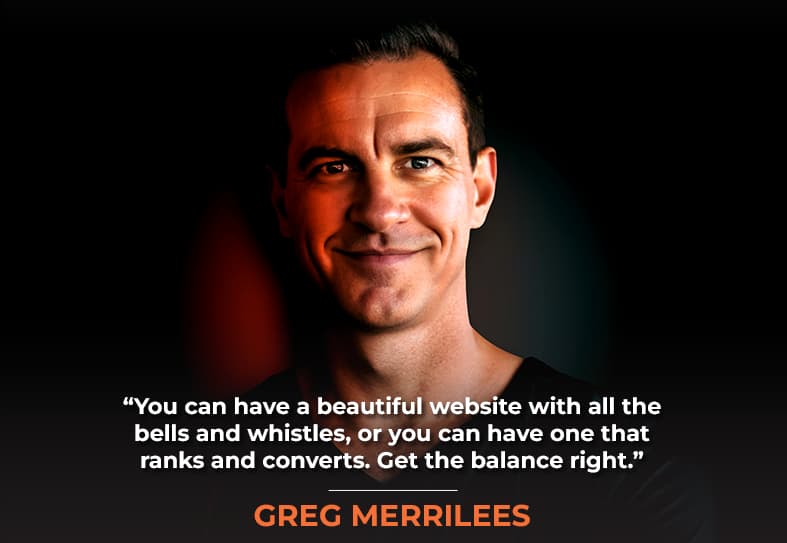
In This Episode
-
- [05:45] – Stephan explains the evolution of the What Is My IP Address site from a simple IP lookup tool to a comprehensive resource on cybersecurity and privacy.
- [09:34] – Greg recalls the website redesign he oversaw with Stephan in 2019, which aimed to uplevel the look and feel without alienating the visitors.
- [17:09] – The importance of a well-organized top navigation and secondary navigation is highlighted, ensuring a user-friendly experience.
- [24:49] – The conversation touches on the strategic use of FAQs for SEO and AI visibility.
- [28:18] – Greg and Stephan discuss the importance of personal branding for Chris Parker, including his personal website and social media presence.
- [31:15] – Stephan suggests strategic approaches, such as becoming an author in a specific space, to enhance personal brand and leverage limited resources effectively.
- [53:35] – The use of AI-generated photos for Chris Parker’s website is discussed, showcasing the future of personal branding and the benefits of using AI tools.
- [74:30] – Stephan discusses the growth in the top three and top four to ten positions on search engine results pages, emphasizing the importance of measurement for improvement.
- [78:58] – Stephan emphasizes the importance of viewing business as a partnership with God, leading to remarkable results.
Welcome back, Greg.
Thanks, Stephan. Thank you so much for having me back. Yeah, this is an exciting case study. How many visitors did they have before you started working with them?
2 million. We started in January 2017. Yes, this has been a long-standing client for eight years now.
There’s a lesson right there for anyone listening. Like it’s a long-term investment and the more you stay with an agency to help you with everything that you’ve helped him with, which is not just SEO, I might add. You just keep amplifying the results. So yeah, it’s a testament to that.
Yeah, thank you. When we were recording, Chris and I were working on a case study episode in 2020, and we had reached 6 million unique visits a month, which was amazing. He was over the moon about that. And now we’re at 13 million. We conducted another case study episode last year, and we were at think 12 at the time, which was truly incredible. He shared that this was something he had never anticipated, having never come anywhere near these kinds of numbers.
Working with an agency is a long-term investment. The longer you maintain that partnership—and leverage their support beyond SEO—the more your results compound over time.
So the growth is growing exponentially. It’s growing faster, more recently, by the sounds of it.
Well, wouldn’t I know? I’m not sure if it’s exponential, but certainly it’s been bucking the trend, right? Many people are saying, “Hey, AI is taking a big bite out of our organic traffic” because users are getting their answers directly from Google with AI-generated overviews. With AI mode, if people receive direct answers without clicking through to the website, then traffic would decrease. Maybe impressions go up, and that’s that.
Some people refer to it as a crocodile pattern, where, in their Google search console, they see impressions going up, and then clicks going down, which is unusual. It’s been, you know, in concert one with the other, usually up until you know, just a few months ago, so they’re seeing this pattern.
This is a significant problem for many sites because no clicks or fewer clicks mean less revenue, fewer opportunities, fewer leads, and fewer sales. This is eroding the business proposition and business model of the web, as well as how search is supposed to work and how websites benefit from it. It used to be a symbiotic relationship. Now it’s almost like Google’s a parasite.
It seems that way. Yeah. I guess that’s a good tie into what we’re talking about today, which is building your brand essentially across, you know, your personal brand to your business brand to boost your authority. And these are all the things that you help clients with, especially the client that we’re talking about now, Chris Parker. So Chris is the CEO of What Is My IP Address, but What Is What IS My IP Address, Stephan? What’s it for?
Yeah. The site originally began as a hobby in 2000. He was just doing it really for his own benefit. It was just a lookup tool to identify an IP address. And he never thought it would become popular by any stretch. And in fact, he had a full-time job until, I don’t know, around 2014 or so.
He was operating this just as a side thing. It wasn’t a viable business for the first few years, but it did generate a lot of traffic. So he had to put it into a proper server environment and everything so that it would handle the traffic. Many people use it.
The value proposition has shifted to what people care about most: cybersecurity, privacy, and scam protection.
A lot of people are either in the IT world, where they’re looking up an IP address for, let’s say, a computer that they’re setting up in a cubicle farm for one of the new employees or whatever, or a consumer who’s trying to get configured with a VPN, a virtual private network. They’re unsure if it’s working or not, specifically if it’s changing the IP address, so they test it using whatismyipaddress.com.
So, that’s the primary use case, but Google has been directly answering the question, ‘What is my IP address?’ or ‘What’s my IP,’ and so on, in recent years. And so the value proposition has had to evolve into something that’s more in line with what people looking for an IP address are really interested in. They’re interested in cybersecurity. They’re interested in maintaining their privacy.
They’re interested in avoiding spam, scams, scammers, and other types of security risks. So that’s the pivot, or not, but more like an evolution of the site over the last, I don’t know, seven years. It’s been really focused on providing a lot of value for consumers and IT professionals in those topic spaces, with hundreds of valuable articles that my team has created over the last seven years or so. Yeah, it’s become a really valuable resource beyond just the IP lookup tool.
Incredible. So how does he monetize this website?
Yeah, so advertising is a primary channel. Getting people to sign up as advertisers on a site uses a platform for that. He used to use Google AdSense, but he switched to a different platform. I think I won’t mention the platform because I’m not sure if he wants to share that information. It’s probably figure-outable for somebody who really wants to know, but yeah, I want to be cognizant of the confidentiality between a client and an agency.
However, advertising has been a primary revenue generator for him, as has affiliate revenue. So, when people buy through an affiliate link of his, let’s say they sign up for a VPN service or something that helps protect them from identity theft, he gets a commission on that.
And it’s a seven-figure business, isn’t it? Or something like that.
Yes, yes. That’s something I can share, as he has discussed it publicly on my podcast. So when he was working full-time, he never would have imagined that this could be a seven-figure business. And yet here we are.
I love it. So cool. And you introduced me to Chris. When was that? It was about 2018.
Yeah, in 2018, we embarked on a website redesign of WhatIsMyIPAddress.com, which your team and I oversaw in 2019. We embarked on that engagement, and it went live in 2020. And, yeah, so it really up leveled the look and feel and the brand of What Is My IP Address. Didn’t look so homemade anymore.
It looked really professional, and it was done in a way that didn’t make the visitor feel disoriented or like, “Wow, this is too good for me. This is a big, fancy website owned by a major conglomerate now. Like, I don’t want to use it anymore.” Nope. People stayed loyal. In fact, it has received an increasing amount of traffic and garnered a lot of press.

He’s really done incredibly well with it. Maybe we should show the before and after now, and maybe that was a good time for
Absolutely. All right. So, if you’re listening, please go to YouTube or Stephan’s website, marketingspeak.com, and take a look at this video. Cause we’re showing the before design of what it used to look like prior to 2018. And as you can see, there’s got some white blank rectangles on it. That’s really the advertising space.
So that was sort of all, all over this, which is really important because obviously it’s one of the ways that he monetizes the website. Apart from that, we’re just looking at it now without those ads, which already look quite busy.
Yeah. So there were ads on both sides, left and right. There is an ad unit that appears as blank above the IP address, underneath the top navigation. And, yeah. There were multiple ad units there, and still are. But it was done in a way that didn’t alienate the visitor. It was clearly ad-supported. I mean, they’re getting a free service.
You’re not designing your website for you. You’re creating it to solve your visitor’s problem. Share on XIt’s not just an IP lookup; there are a lot of details, and a significant amount of work goes into making this really work. You know, so finding the location of that IP address and performing various additional lookups to see if it’s on blacklists, etc. That all costs money. So the visitors are amenable to it being ad-supported.
Yeah. And so, we’re obviously very conversion-focused in our design. And usually that means, you know, having just a single call to action and cause everything else is a distraction. However, in this case, we know that ad revenue is the primary way he monetizes. So we had to approach it very differently and ensure that he didn’t lose any ad revenue while focusing on the things we needed. He made it clear that we were the most important.
So, this, this is what it used to look like before, and all the internal pages are pretty much the same. It may take some time to access an individual page because it’s currently archived on the Wayback Machine, as we explained in previous podcasts. However, I’m going to switch to the new design now, and to show you, this is what it looks like. It still has all these ads flashing, but when the ads disappear, it’s just so much cleaner. And there’s just one thing. For people to do. It’ll show their IP address, and then it has a big red contrast button that says ‘Hide My IP Address Now.’
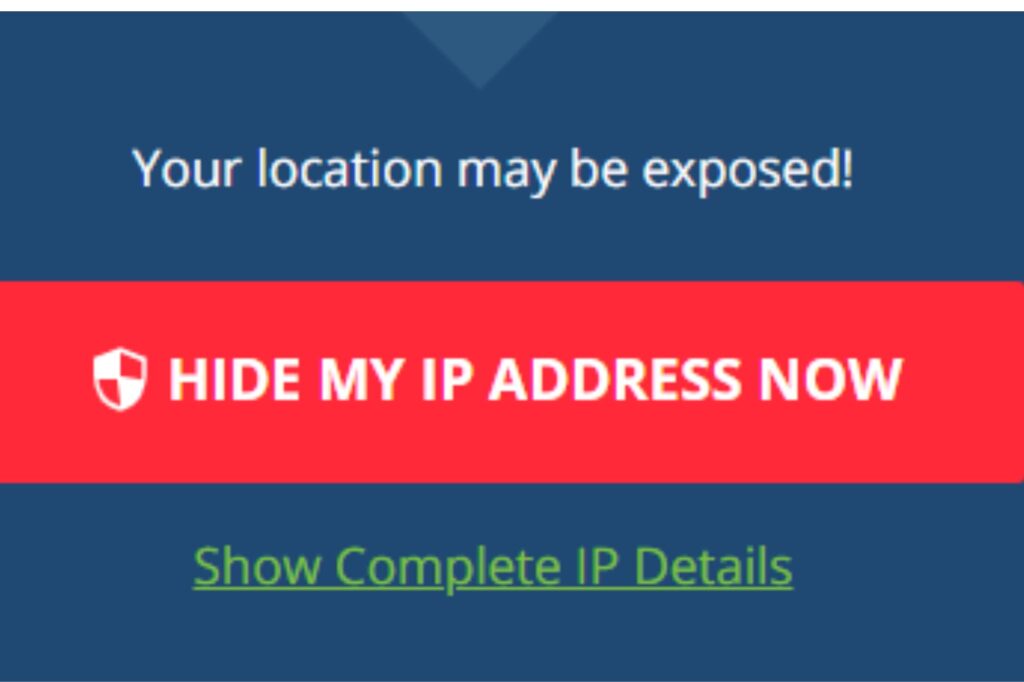
And then everything else on the site is visual. It’s all there, but it’s just in the right visual hierarchy so that we put the main focus on the call to action. The ads are still everywhere. They’re very distracting, but that’s a good thing when you’re trying to make money from the ads. However, we then move on to the three other areas that Stephan mentioned earlier.
What is your biggest concern about using the internet: security, privacy, or do these concerns extend to individual pages? However, this is particularly important because when designing a website, you’re not designing for yourself. You’re designed to solve a problem of your prospects or your, you know, people that use your website. So, just this question alone, which is your biggest concern about using the internet, is a really smart way to segment based on the reason they’re there and the problem you’re trying to solve for them.
And what are those three problems? What are the three buckets in this case?
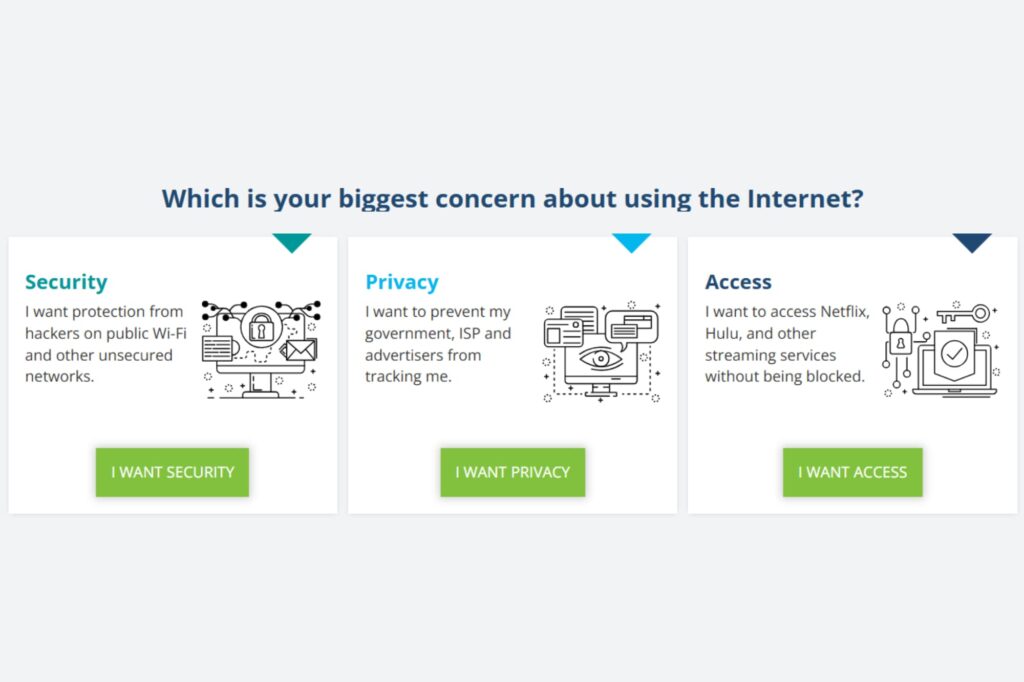
Yeah. So, security, privacy, and access, but it says I want protection from hackers on public WiFi and other unsecured networks. And then privacy is what I want to prevent my government ISP and advertisers from tracking me. And then, I want to access Netflix, Hulu, and other streaming services without being blocked. And just prompted me to say that Stephan was great because I just sort of skimmed over them, but when you really read the actual description of each of those problems, it gives so much more clarity. And I guess that’s a lesson for anyone. Like, what is the benefit? If you just have like, “here’s the three things we do,” but if you don’t explain how people will benefit and what you can actually do with each of these options, yeah, it won’t get as much click through.
Yes, this is very simple, but it’s also very conversion-focused, and it has indeed boosted their results. And, of course, we discuss what Stephan has done to increase a lot more traffic. However, part of improving traffic is when Google, or LLMs, provide users with what they want. And in other words, one of the algorithm things is when people click through to something, that’s a conversion, right? Stephan and that signals to Google that they’re getting what they want. Is that how it works with a billion other things within the algorithm?
Well, if so, Google’s not using your Google Analytics data against you to penalize you if you’re experiencing a high bounce rate or issues with people being dissatisfied once they’re on the site. What Google does use against you and can see without looking at your Google Analytics is the dwell time. If somebody bounces out of your site and then clicks on another search result, see the search results as a click track.
If nobody wants to stick around on your site, then Google will demote your site because they’re monitoring dwell time and clicks.
So, if someone clicks on result number two and that’s you, and they’re dissatisfied, the user is, and they come back and click on result number three, 10 seconds later, Google can measure that and treat you accordingly. So, if nobody wants to stick around on your site, then Google will demote your site because they’re monitoring dwell time and clicks.
But that’s once you’re on the site, and I start clicking around as a user. That’s private information that Google’s not using to demote you or to raise your rankings. If someone stays on your site for an hour or they stay for two minutes, as long as they’re not bouncing back to go do another search or click on another result on the page in Google, then Google doesn’t know what’s happening. Maybe you went to lunch. Who knows?
Haha, yeah. Got it. Understood.
Yeah, but I do love it like this, this little nuance of that big red hide my IP address now button that was not present in the previous version is a major conversion event that drives serious revenue for the client for Chris, because when you want to hide your IP address, that means you want a VPN.
And he earns a significant amount of money from people signing up for VPNs when they use his affiliate link. So, he has a comprehensive set of tools, resources, information, comparison charts, and everything related to all the different VPNs. They’re all; they all click through an affiliate link so that he will make a commission once somebody signs up.
Excellent. And just on that. So all those things are now in a very well-organized, simple-to-follow top navigation. We have, you know, my IP lookup, hide my IP, and VPNs with a comprehensive list, including reviews and comparisons, which is super helpful.

Yeah, that’s a drop down, but the other three are tools and they just lead to one page with the tool on it. And then we have another drop down yet with additional tools and then the learning center.
So, but there’s a lot in each of these dropdowns, but when you look at the top nav without hovering over it, it’s so simple and easy to understand. It’s very well organized and you’ll notice there’s a secondary top nav above the main navigation that is for secondary things that aren’t monetary, they’re not going to be monetized from about or press or podcasts or support, but yeah, they’re still there. They’re just not as prominent. So I just think it’s well organized.
If you do have a lot of things to put in the top nav, potentially look at splitting it into two visual hierarchies. So the main one is more prominent and then the other one just smaller text links only. yeah, in this case.
Yes, this is an unusual one because most of the sites we have case-studied had just a magnifying glass icon, and then you had to click on it to display the search field. In this case, the search field is displayed by default. Why is that important in this example?
Yeah. So, realistically, most websites need to have a proper, prominent search function. However, it’s more prominent for websites like this and e-commerce sites, because there are numerous different results. For instance, if it’s a personal brand website or a service business, it usually yields fewer results as it gets in the way of other things that we want people to do. Generally, we’ll compress it into a small magnifying glass. And then when you press it, it expands into its own search box. However, this is particularly important for conversions on e-commerce websites and similar platforms. We simply make it more prominent for that reason.
SEO-friendly FAQs lead to free ranking fuel. Stop hiding your content. When you actually read the description of each problem, it provides much more clarity. Share on XYeah. In this specific example, people are here to obtain an IP address, and it may not be the IP address of their own computer. It might be an IP address. Let’s say that they’re managing some online forum, and that forum has a potential spammer on it. And you’re trying to look up that IP address associated with the contributor’s posts or comments, and you can just paste in that IP address right into the search box without having to click on the magnifying glass first to display the field.
And so, this is a tool that many people are using to view multiple IP addresses, and we want to remove all friction. It’s extremely simple for them, and without needing an extra click to display the field, they can simply drop in the IP address they want to look up.
Exactly. And so you think, yeah, it’s more important for people to find what they want, as opposed to, like I said before, for another type of website where it’s more important for them to click on the top navigation than the search. That’s why we changed the visual hierarchy.

Yeah. Yeah. So this is good. In the case of our website, there are various use cases. Maybe there’s a lot of opportunity there, a lot of potential for people to go down different kinds of rabbit holes or probably if you add up everything in the dropdowns, several dozen different things they could go to having just a very simple three bucket approach based on their problem they’re trying to solve is a really viable approach to get somebody moving down your funnel and through your site hierarchy, right?
Yeah, exactly. Exactly. So, yeah, everything is thought through logically, considering what’s most important. What do people want? And we want to give them what they want above the fall. What are they on the website for? And then we give them the secondary options. And then, obviously, we want a little bit of social proof. And in this case, it’s authority-boosting logos, as seen on The Washington Post, CNN, USA Today, Fox News, The Guardian, etc.
There are numerous logos in there that his ideal target audience would recognize, as well as several tech-related prospects, such as PCWorld, among others. So, yeah, always be careful when you are putting on, as they’re completely relevant to your audience, and they’ll understand them.
And then there are more ads. Then he introduces his podcasts right on the homepage, which I think is really clever, which is the Easy Prey Podcast And we’re going to talk about that website in this case study episode as well. However, it’s beneficial to cross-promote. If you have multiple websites, consider cross-promoting them to drive traffic from one to the other.
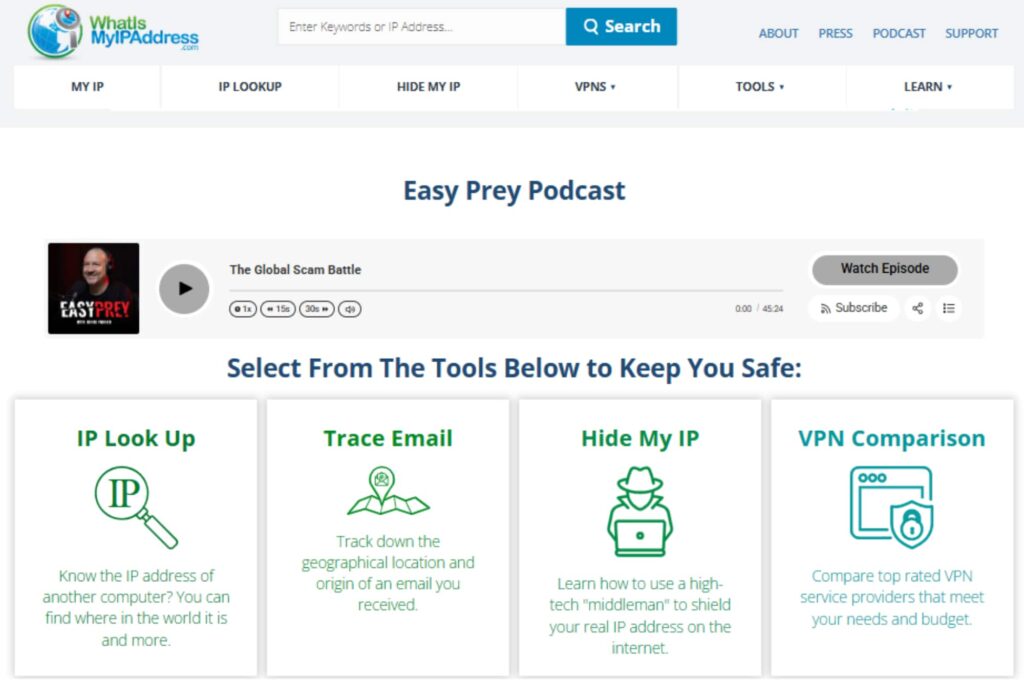
Yeah. And when you have a new podcast or one that doesn’t receive many downloads or watch time, if it’s also on YouTube, then using your larger website, like Chris is doing here, is essential to achieve the download numbers and watch time you want. Because, after all, he’s basically his own advertiser.
Right.
He’s advertising his own podcast, and he’s getting, you know, whatever number of downloads per month. I can’t really share it, but it’s, it’s more than I get, substantially more than I get, because he’s got a huge captive audience here on this, What Is My IP Address, site that he can get people who are privacy and security minded to start listening to a show.
Yeah, why not?
Yeah. Maybe that’ll change after this episode. Yeah. Love that. Yeah. He also has connections to some well-known names in the privacy industry.
Yeah, that’s not just for social proof. That is actually for SEO. That was a recommendation I made that he implemented, and that was to drive link equity to the most valuable episodes on the easyprey.com site. So John McAfee was a big guest. Actually got him, John McAfee, to be interviewed, which was a huge win.
SEO wins often come from boosting a page from page two to page one, not just pushing your top sellers.
Fabulous interview and very popular obviously. And so that’s one of the first ones listed here, sending a link, sending link equity, and sending PageRank over from this massively popular, high domain rating website. What Is My IP address over to easyprey.com, which has made a significant difference in helping him rank for search queries related to John McAfee, privacy, and other relevant topics, particularly with the episode page on EasyPrey.
Great ideas, Stephan. Yeah. Love that. All right. And then, further down, we have some additional ways of segmenting people and helping them on their journey. You know, we have, it’s like from the tools.
And by the way, just to point out that this is like, this is very applicable and flexible, this approach of saying, I want to drive people to, and the case I just gave, certain episodes, it’s not like these are the best episodes on my show. No, these are the ones I want to rank the most in Google.
And so, when you’re checking out these featured blog posts, episodes, products, service pages, or whatever, that is oftentimes a missed opportunity where they’re just putting ones that have been considered popular in the past or whatever, or they want to sell more of the product, but they’re not thinking about the SEO implications. Like, “I’m at the top of page two in Google. If I could only reach the bottom page one, that would make a difference for this very important product, but it’s not a top seller. I should feature it anyway, even though it’s a top seller, I’ll feature it so that it’ll send link equity and boost that page and its rankings, hopefully from page two to page one.”
Love it. Cool. Yeah. And so, we then have another section to help people, which segments them and takes them directly to the tool. You know, that’s right for them basically. There are eight tools available, along with FAQs. Why are these on the page, Stephan?
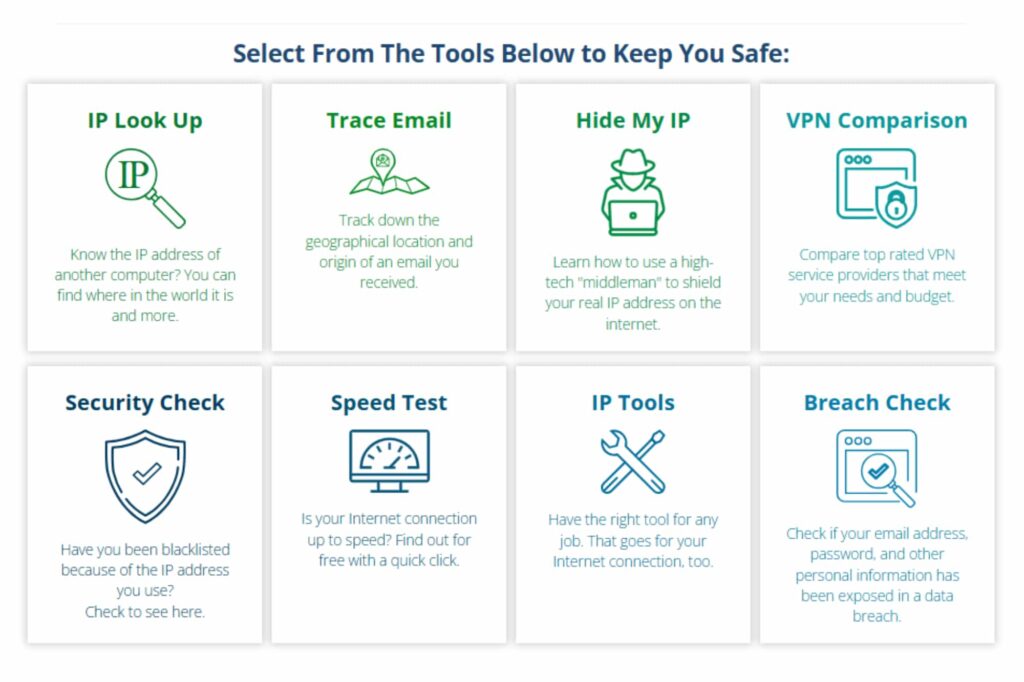
Yeah. So that’s really for SEO purposes more than anything. Additionally, for LLMs, when you answer questions and then mark them up in a schema format that indicates whether it’s an FAQ or a Q&A format, it’s more likely to be used in LLM responses, such as ChatGPT. It’s more likely to be used by Google and featured in features like the ‘People Also Ask’ boxes as a featured answer. So that’s why that’s there.
This is the most important page of the site. Thus, Ahrefs is a very popular SEO tool. DR (domain rating) is a very important metric from Ahrefs. If people listening who understand the importance of that metric, they’re like, Wow, that’s a major site that has a lot of link equity. Just by leveraging this particular page, which has a massive amount of, well, it’s not DR, it would be UR because we’re talking about an individual page now.
Overall, the DR is in the eighties, but the UR of this particular page is the highest UR score across the site. UR URL rating, so each page has its own authority score. And this is the one, this is the golden page. So leverage it as much as you can with your best stuff. And in this case, having FAQs and links to the most valuable and important episode pages on EasyPrey, and so on. That’s all done very strategically.
Very cool. Yeah. From my perspective, I think this section appears somewhat unappealing. However, that’s what I always say to clients. You have to strike the right balance. Like, what do you want? Do you want a beautiful website with all the bells and whistles, and one that’s super fancy, but with no text on it, because you want to be like Apple? Or do you want it to rank and convert? It’s about finding that balance, right? You can still have a beautiful design, but some sections need to consider other goals, such as the FAQ.
Yeah, right. So I think it’s a great point. So, if you look at a typical FAQ page on a contemporary or modern-designed website, you’ll see a question, followed by a plus sign with no answer displayed until you click the plus sign or the down arrow. And then the next question, next question, next question, where all of the answers, except perhaps the first one, are hidden.
Only the first answer or no answers are displayed, but that’s where all the keyword-rich, valuable content is, and now you’re hiding it. If Google perceives content as hidden by default, requiring users to click a plus sign or a down arrow to display it, it will, of course, discount that hidden content, not completely, but to some degree. So, if you truly care about the content that is hidden using the plus sign or down arrow, then display it by default. And that’s why these are displayed completely without having those down arrows or plus signs.

There you go. All right. So we spent a lot of time just on the homepage. What I thought was that we could discuss the about page on the press page, and then that would tie into the other websites we’ve designed for him and why they’re important as well. What are your thoughts?
Actually, why don’t pick the About page of Chris’s site? This is still the old about page that hasn’t been updated to the new format. That will go live in the next several weeks, but not yet. So we’ll talk about the about page and the storytelling and everything. The press page is very important for social proof. And I think we’ve talked about that before on previous episodes, but out of all the episodes that we’ve done on case studies, I think almost certainly this is the most impressive of the press pages because he doesn’t even have to try. He gets media mentions all the time. It’s really cool.
So, my team and I will periodically conduct a Google News archive search to see where the site and he, along with his podcast, are being mentioned. And then we’ll include these on this press page and on the press pages for his personal site and the podcast site if it’s actually a podcast mention.
And he receives mentions in The Washington Post, PC World, The Guardian, CBS, and other notable publications. And he even got a TV appearance that wasn’t one he had solicited.
Amazing. Yeah.
Yeah. So this is an opportunity for every site. If you want to get press or you’ve already received it, you need to feature it, and it should be easily accessible in the top navigation without requiring a search. Shouldn’t be hidden away under an ‘About’ sub-nav, where you have to mouse over it. It should be particularly prominent because journalists, TV producers, podcast hosts, and others won’t dig around for it. They’re going to quickly have a look to see if this guy is legit or this gal is legit? Should I have them on my show?
Should I use them as a source for my article? Not sure. Oh, they have a press page. Let me take a quick look. Oh yeah, yeah. They’ve been clear that they’re a celebrity. They’ve been a subject matter expert for a long time, cited in a lot of places. Yep, I’ll use this person.
Yeah, got it. Good tip. All right, cool. And then he has a downloadable version for his press kit as well, which is super helpful for event organizers or TV executives.

Yeah. So, any kind of press, whether it’s a journalist or a TV producer for a news program, or even someone looking for speaking gigs, knows that the conference producer’ll organize speaking opportunities. So, they’re going to be looking for a speaking kid, press kid, or media kit to get a sense of you. And in a PDF format, you don’t have to dig around and click around a whole bunch of different pages to collect that information.
Very cool. So speaking of, like, all this is, you know, like boosting his authority. There’s another bit of advice you gave to him, Stephan, which is to write a book. Why did you ask him to write a book? And, yeah, what was the purpose of that?
Yeah, so it was a very different sort of, let’s say, unfolding of this particular book project than others where I have advised the client to write a book. We recently worked with the Yosha Law Firm. So that’s a great case study. I convinced Brandon Yosha to write a book, and I brought in a ghostwriter for him to hire; it turned out great. It was a memoir, and it really helped him build his status and reputation. He was already a very successful lawyer, well-regarded, but this really elevated him to another level.
This is a very different approach that emerged, and it was actually the original idea for my book. So it wasn’t called Privacy Crisis. It was called Data Rights. And I was the solo author. I have been using my long-term ghostwriter, whom I’ve been working with since the late 2000s. Every book that I have produced, I used him to help me, because it takes a village, or at least it takes a ghostwriter, I think.
Yeah.
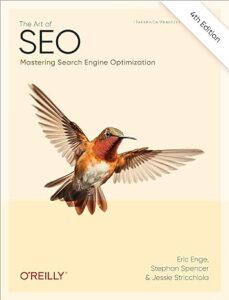
It’s not easy to write a book on your own, or even with a couple of co-authors; it’s still a huge task. Each edition of The Art of SEO was two years in the making. We’re four editions into the Art of SEO, so two years of work for each one. That’s a lot, and it’s probably minimum wage when you consider the number of hours and the output in terms of royalties.
It’s not much. But it’s a huge business card. It’s a really effective business card, a big one, right? So in this case, it was my book. And why was I writing a book on data rights? Well, I was guided. So it was really outside my comfort zone. I don’t know. I just follow my guidance.
I follow the still small voice, and yeah, several, maybe it was two years into it. Perhaps it was only a year and a half; I’m not sure. However, somewhere along the way, I received guidance to invite Chris, my client and the subject of this case study, to co-author with me.
So it’s still called Data Rights, and we still had my ghostwriter doing a lot of the heavy lifting, but now Chris has agreed to be a co-author. And months after that, I don’t know, maybe it was four or five, six months after that, I got the nudge to actually pull out of the project myself, not so much as like not helping Chris anymore, but not being a named author on the cover. This is Chris’s first solo-authored book.
And that makes it a huge deal for him. He’s not the second author on a book that, you know, it’s like, “Stephan has yet another book out, and who’s this other guy?” Nope. This is Chris Parker’s first book, and it’s a doozy. It’s amazing. So, you know,Chris has done a lot to make this. I’m really proud of him and proud of what we’ve accomplished together. And I don’t need to be an author of a book outside of my topic space.
I really want this to do well, not just for Chris, but for the world. Since I was guided to work on this book, it has been beneficial to the world. Know privacy is being eroded, and people’s data is being used against them. And if you’re not paying for the service, then you’re not the customer, you’re the product.
People are often unaware of the full implications. As AI takes over the world, privacy is likely to become increasingly scarce. We need to take action now to protect ourselves. Yes, this book is a valuable resource in that regard. And so I’m really happy that Chris saw the opportunity and recognized its value as well. And he has taken the reins.
Love that. Yep. Incredible. Brand new. I knew part of it. Yeah. That’s an incredible story. And it’s brand new, isn’t it? So, therefore, this website that we’re looking at now is something that, you know, you had our team design, and nothing existed before this. Let’s discuss this further.

Yeah, and by the way, Privacy Crisis, as the title of the book came about in part because I’m really good at doing aftermarket domain lookups and trying to find domains for sale. If you tried to find a domain that was available to purchase for 10 bucks or whatever, good luck. But if you’re willing to buy an aftermarket domain and spend at least four figures on it.
Then you have a world of opportunity available to you, and the privacy crisis was one of those domains that he could have bought, which just makes it sound so much cooler to try and limit yourself to just domains that are available to register immediately. That’s just, you’re going to be sad. Everything good is taken.
Yeah. Be prepared to pay a lot for a two-word domain.com. Love it. Awesome brand name. And so, we had our team. I think we dealt with you with this brief, didn’t we? For the book website. And so we also designed the book cover based on Stephan’s direction.
It’s Chris and Steph, and we sent them several different versions for feedback. And yeah, this is the one that they chose, which I think is really cool. I think the color palette is great. We just wanted to have an uplifting feel. Think about privacy and crisis. People might think doom and gloom and be very negative.
Yeah, we don’t want this to be a dystopian novel. We want this to be a helpful how-to.
Exactly. And so that’s why it’s the bright yellow and orange color palette.
Yes, and it’s not a scary, intimidating security camera that you would see on the street, designed to catch criminals. This is more like a personal webcam. And there are some subtle elements here that you incorporated as well, such as the C in CRISIS, which features a small key in the middle that doesn’t look intimidating or scary. It’s just a reminder like, “Hey, you need to maintain your privacy because that’s kind of the key to the kingdom.”
A book is the ultimate business card—it instantly elevates your authority.
Exactly. And there’s a little lock negative, you know, what would you call it —a silhouette in the letter ‘A’ in privacy as well. So it’s like a lock and key. Yeah, yeah, that’s a good one too.
It’s a little less obvious because it’s in the middle of the word, and ‘PRIVACY’ is a little bit smaller than ‘CRISIS,’ but it is also a nice, subtle element that reminds us that the topic of this book is securing your privacy, and it’s not a novel. It’s not a dystopian sci-fi, you know, get all freaked out sort of book.
Totally. Yeah. And so, the color palette features a dark background above the fault, but not in every section. It’s not a dark background website. We just wanted to give the book a lot of emphasis. So we did a high contrast, and the book’s very light. The background needs to be quite dark. Then we have a blue call action to give the call to action a lot of emphasis as well, and a lot of attention. What I love about this is that, obviously, because Chris is all about privacy.
So, he’s given away the main call to action is to get the book for free, or however you would say it. And so, what that means is that people can opt in for it. Sure. But then he says download anonymously. So you can, that’s your option. You can just download it without giving an email, which I think is really true to the main message of this whole book and his methodology.
Yes, and it’s also available on his other sites. This is a pop-up or modal box with a first name and email field, which is like, “Okay, I have to give away a little bit of my privacy to this guy when he’s trying to teach me about how to maintain my privacy. That’s kind of ironic. No, no, wait a second. There’s a small section underneath that states, ‘We respect your privacy.’ Don’t want to share your email. Download anonymously”
And it’s not super tiny. It’s not completely hidden. The word download is in all caps. It’s just that he’s a very straightforward person, and he’s not trying to game anybody. He wants to truly help.
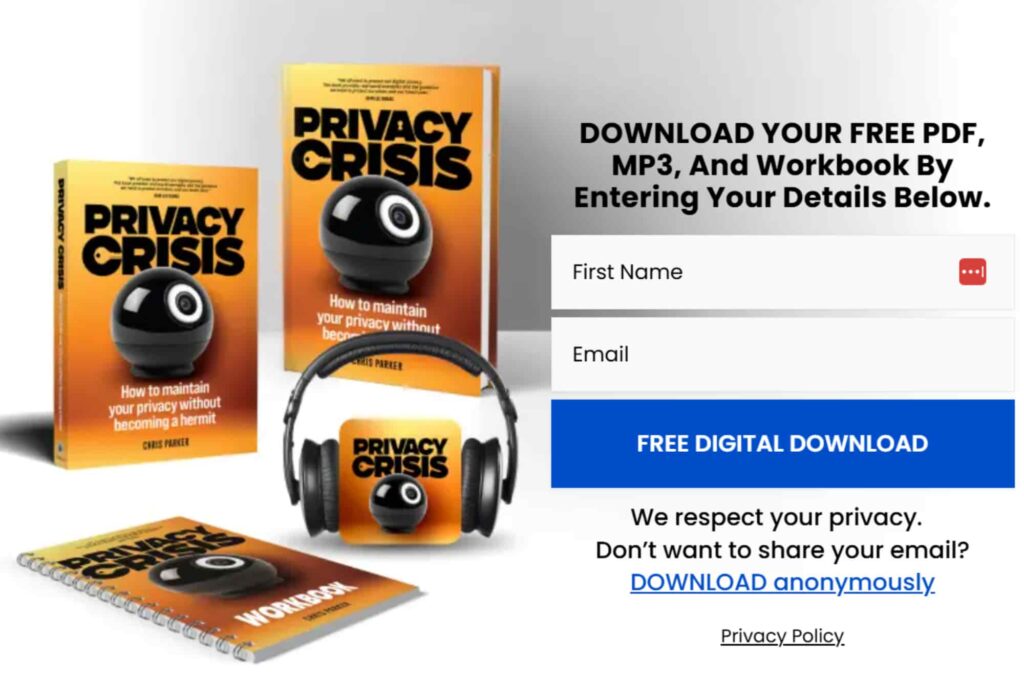
Yeah. However, I think it’s smart because some people may want to join his email list to receive more valuable content from Chris, the expert, giving them a choice. You can either provide your email address or download without one. So I think that’s really smart.
Yeah. Yes. And what a value stack you have when you see what you’re getting. And that’s part of the reason we use the word ‘gratis,’ because I actually learned this from Jay Abraham. He prefers to use the word “gratis” instead of “free.” Free sounds cheap, and it sounds like it’s just so overused. So get the free book. It’s more like this is a value stack that is just beyond belief. You don’t just get a digital download of the manuscript. You also get a companion workbook. You also receive the audiobook, which is available for purchase on Audible. You know, it’s like not just, you know, one thing, it’s all three. And these are valuable, expensive things that you’d spend, let’s say, 10 bucks or 20 bucks for on a site like Amazon.
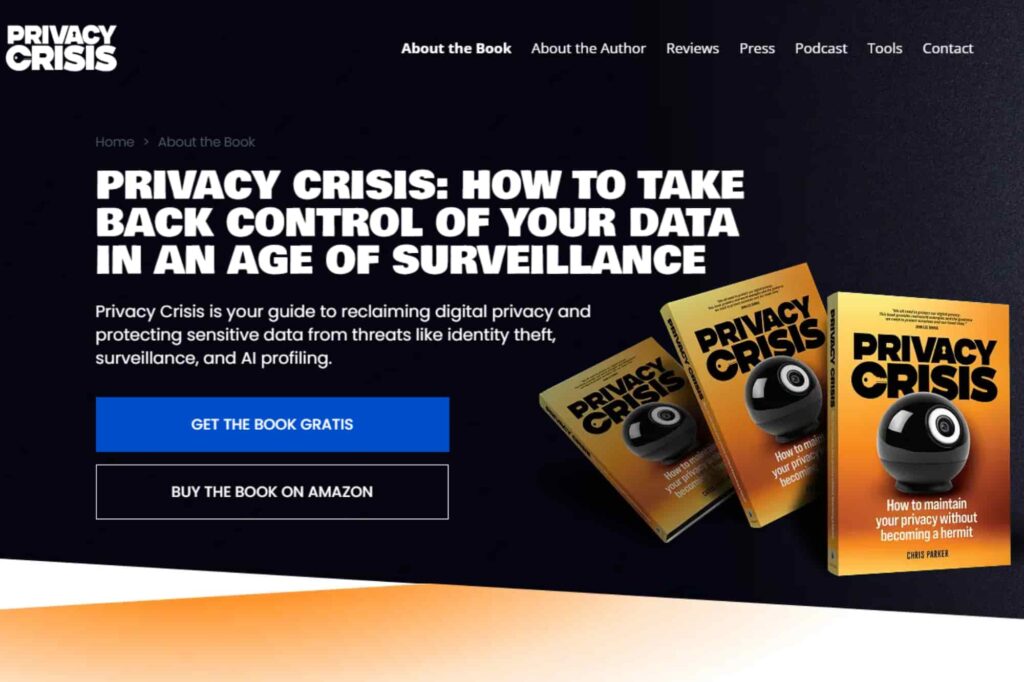
So, he’s offering it completely free, and you can purchase the paperback or hardback on Amazon, or opt for the Audible version. You could buy a Kindle version. He is pricing the Kindle version very inexpensively to try to get people to buy the book, especially in these early days of the book launch. And then hopefully get more verified purchasers to write reviews.
For Amazon, that’s very important for any new author. It’s really, really important to get those reviews and ratings. That’s the reasoning behind it. But this is unusual. Most authors are not giving away the audiobook. They’re not giving away the entire manuscript, only a chapter or a sample of the book, a part of it, not the whole thing. He’s doing all of it.
Yeah. No email. Incredible. Yep. Additionally, you also helped him gather some social proof for the book before its release. How’d you go about doing that? And it’s good social proof.
Yeah. So I have a number of contacts. Yes. I’ve been reaching out to different experts, authors, speakers, friends, and industry contacts for a long time — decades —because with each edition of the book, I want to gather more endorsement quotes, also known as book blurbs. And so I reached out to my network, and secured connections with some big names: including Dr. Robert Cialdini, Robert Allen, who has sold tens of millions of books, and Nir Eyal, author of Indistractable. Yeah, he got Rebecca Harrell. She was a guest on his podcast, but I also got the others. It’s a great book. So people are willing. Like Justin Donald, he was really impressed with the book. I reached out to him.
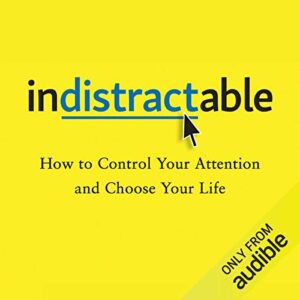
I have a lot of social capital with these folks. I help them out with things, and then they’re willing to help me or my client. And when he read it, he’s like, “This is actually a very valuable book. This is really important. I’m super excited for it to come out, and I’ll do whatever I can to support you.”
Love it. Yeah. And a few others as well. Incredible. Which, like you said, “it’s so important,” but I also like your strategy of putting the Kindle $1 on Amazon. That’s a great idea. I’m going to do that.
Yeah. And it doesn’t have to be like forever. You can do it for the first two months or whatever. You do it for a day, even if you have a very expensive book that costs you a lot to produce, and you don’t want to offer it for 99 cents, offer it for a day. Send it to your list that, “Hey, next Tuesday, I am going to offer the book for 99 cents. It’s normally 14.99. It’s 99 cents that day only. And if you want to thank me by writing an honest review. Please do, but there is no obligation to do so. Simply buy the book, share it with all your friends, and get it for just 99 cents. It’s next Tuesday. On sale.”
Yeah. Awesome. While you’re talking, I just skimmed through the homepage, in case anyone’s watching. We might discuss roughly what we’re trying to do with this homepage. So we’re just trying to, obviously, create a benefit-driven headline above the fold that explains what the book’s all about. Some bullets, you know, about the book by Chris Parker, founder of What Is My IP Address, which is really good for a little bit of, you know, authority that links through to what’s my IP address as well. When you click on it.
And then we have a section where she’s really talking to the target audience. It’s just put in a little bit of, you know, truth into why this book’s important and you know, things that they should be familiar of because, know, it says your daughter has been used against you and in a world of blah, blah like it’s pretty important that people understand, you know, why this, this book’s important.
Yeah. I love those bullets too. Underneath, do these sound familiar? Now you read them.
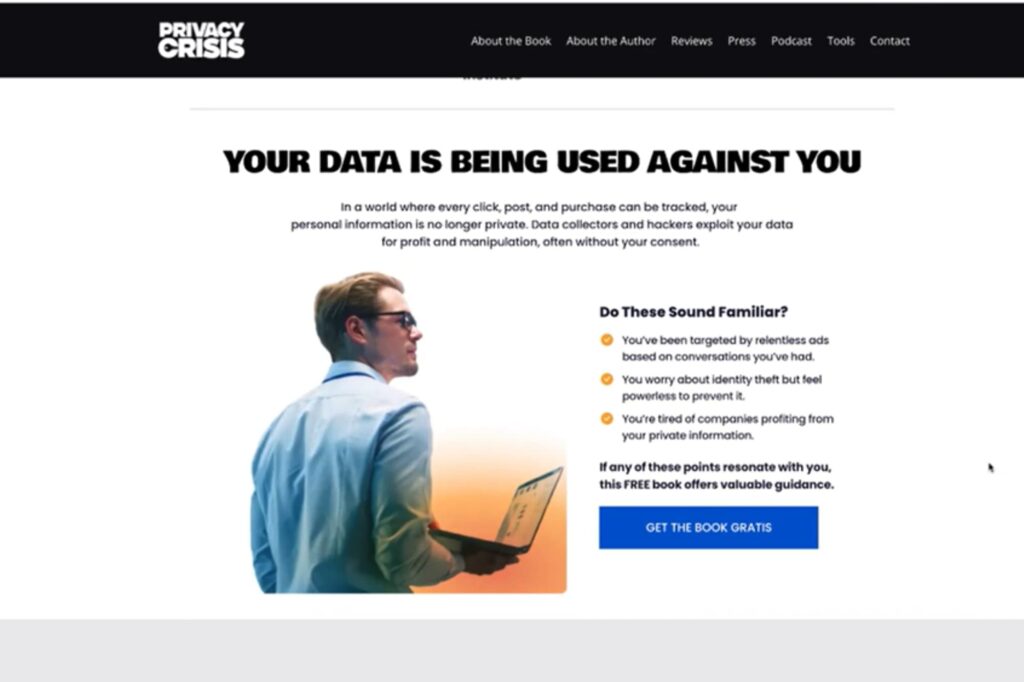
Yeah. Did these, okay. Did these sound familiar? You’ve been targeted by relentless ads based on conversations you’ve had. You worry about identity theft, but feel powerless to prevent it. And the third one is you’re tired of companies profiting from your private information. If any of these points resonate with you, this free book offers valuable guidance. So get the book, Gratis is the call to action. So yeah, really cool. You know, really put a little bit of fear into them, but it’s true. You know, all this stuff is the reason why you should buy this book or download it for free. No, it’s not.
Yeah. But it’s not over the top. No, it’s not doom and gloom. It’s just like, “Hey, this is, this is serious. You need to take this seriously.”
Exactly. And then we’ll just go a little bit deeper. Another section talking about the problems, and you know, you can, why the book’s important to help avoid them, avoid the problems. However, there’s a brief section about the author. We’ll talk about the photo in a minute, which was generated by AI. And we’ll talk about that whole process. Cause I think as a listener or viewer, you’ll see what we started with, and it’s fascinating the results, but yeah. And then we have a section where you can buy the book or get it for free. You can donate to a privacy-focused foundation or a charity.
And he’d make no money off of that. Right. So, you’re donating to, say, the EFF, the Electronic Frontier Foundation; he’s making nothing off of that. Why is he doing that? For instance, if you think about it, this is a section that outlines how you can help us. Like this is how you can be part of the movement. Be part of the change you want to see in the world, and supporting a privacy-focused foundation such as the EFF will help further that mission, even if it doesn’t directly benefit Chris personally. Buying the book, of course, will help Chris personally because it’ll help fund this endeavor, and he’ll be able to, let’s say, “buy more Amazon ads to promote the book,” as he’s generating some revenue from it and so forth. Yeah.
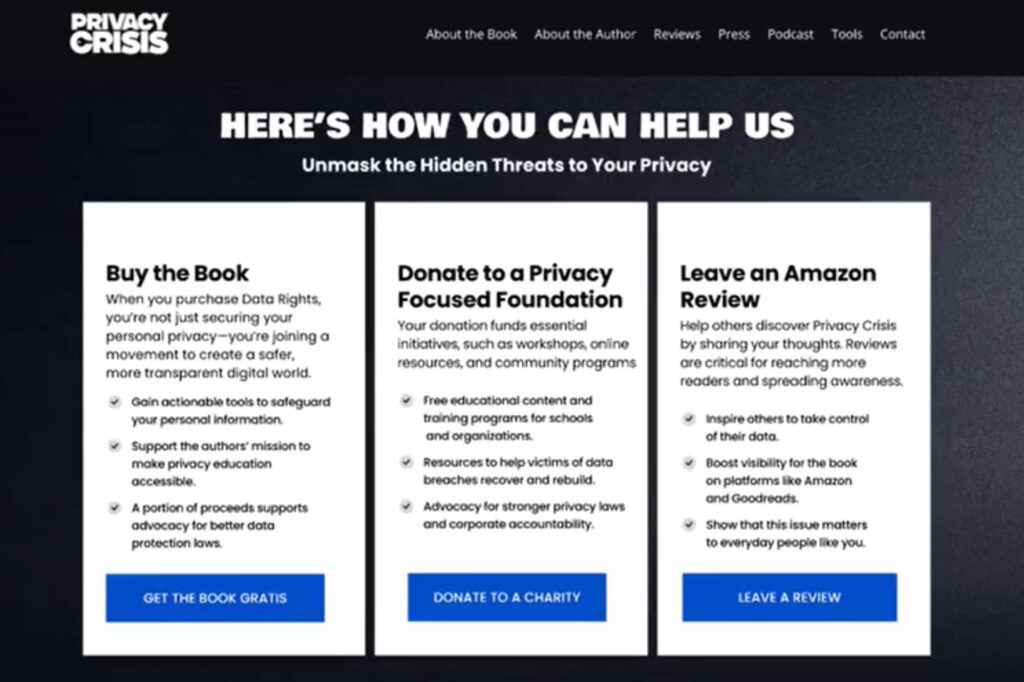
Exactly. And like leaving a review, the more people that, you know, see this book, the more people that buy it, the more people he helps. So yeah, it’s really helping everybody. It’s a pretty good section. And he has a video section. I’m not sure what’s in that video, but it has more social proof.
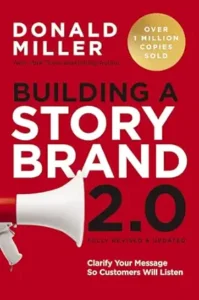
Actually, that was a great idea you came up with, as it was based on the video you told me about, Building a StoryBrand 2.0, the second edition. So, Donald Miller, in his plaid flannel shirt, looking really friendly and not intimidating, is having a chat with you, telling you about the Story Brand framework and all that.
We modeled it after your suggestion. I came up with the idea, and my team actually developed the script for his video. And then he did a bit, and then he got in front of his camera and did the video. And then we did all the editing after it. I’m not sure if you’d like to share a snippet of it.
Let’s take a look.
As you can see, it’s got B-roll footage, it’s got graphics and different kinds of effects, and it’s got the social proof and the value proposition and all that. It’s a helpful video.
The music, I think, is really cool as well, which I heard in the background.
Yeah, yeah, so that was my team.
Yeah, nice one. Yeah. More social proof. And then, one final call to action: get the book for free. But then, he introduces his podcast, which is also related to this brand, where he interviews experts about internet privacy-related issues. And yeah. So the whole.
Yeah. I mean, it says much about scams or cybersecurity, as it’s actually more about cybersecurity and scams, and avoiding them, than it is about privacy. However, he has dozens of episodes that focus on the topic of privacy. So, we took those episodes and featured some of the biggest ones on the privacy crisis homepage. Then, we directed visitors to the EasyPrey website to subscribe and listen to other episodes.
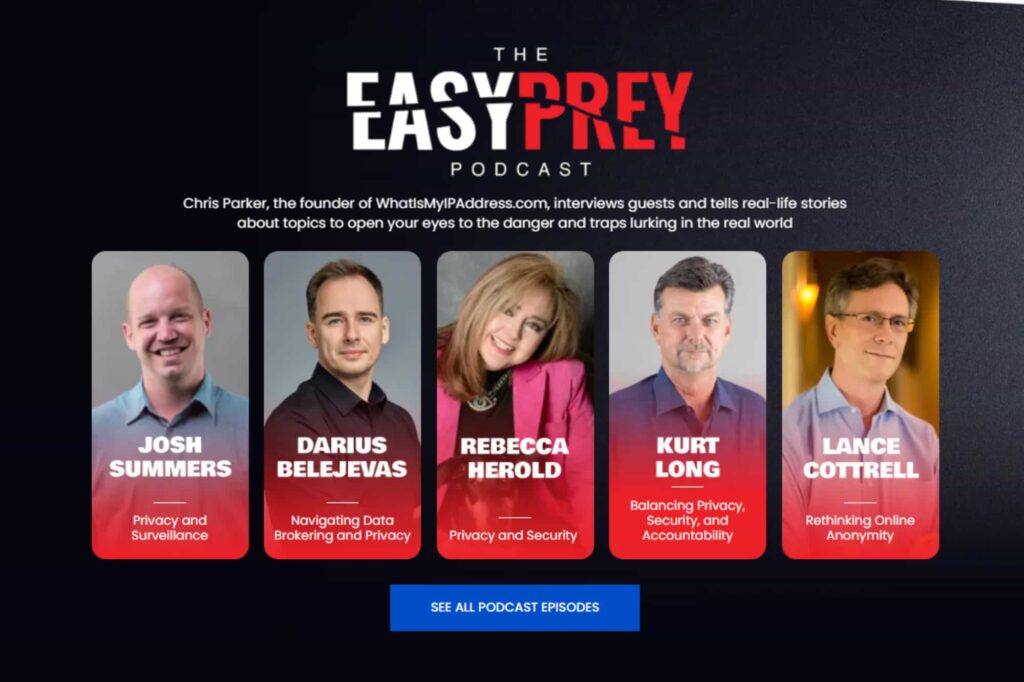
Understood. Yeah. And we’ll have a look at that website too, because there are three websites that we’re going to examine, which share a similar look and feel, and a consistent brand, but will have their own unique style.
So, that’s the homepage. Mean, there’s a whole bunch of other internal pages, but you know, for the sake of time, I just thought we’d probably, you can browse these websites at your own pace, privacycrisis.com. But I thought maybe we’d flip to the Chris Parker website to show the viewer what it used to look like before we redesigned it. And, look, this is an extremely old website. Chris had no reason to put any effort into this initially, until now that he has the book, people will be Googling or searching for his name. That’s why he’s investing in redoing his personal brand website.
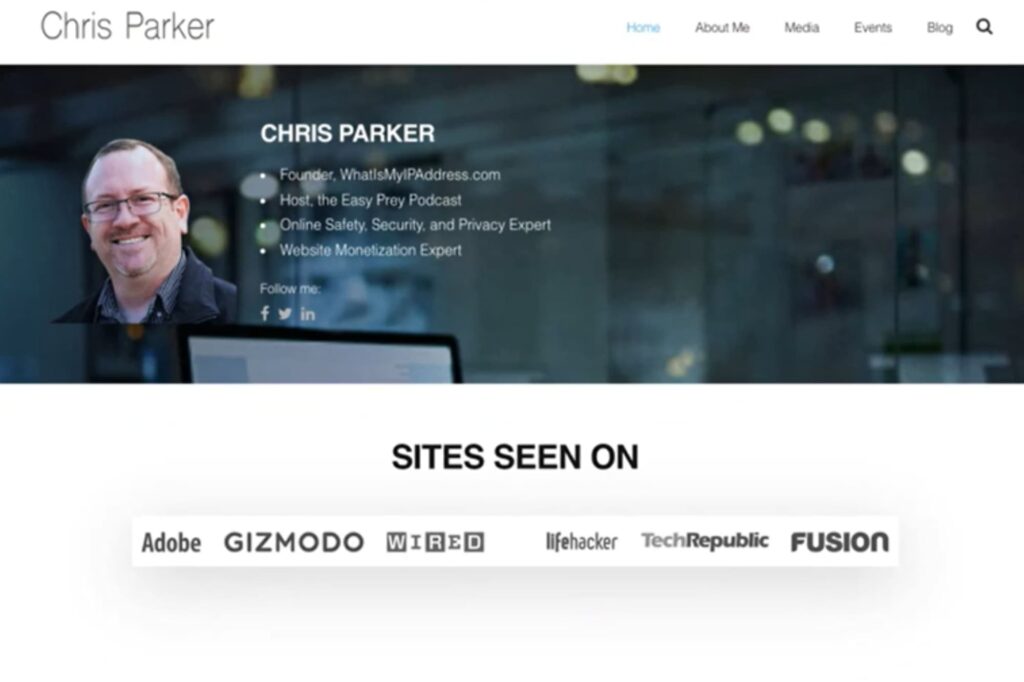
Yeah. And that personal brand website might be the entry point for a conference organizer to hire him to do a keynote or for a major news program to invite him on their show. This is now a serious opportunity. He needs to significantly elevate his personal brand. So that’s why we, you and your team, redesigned the Chris Parker site, cgparker.com. As you can see, it desperately needed it, but now we have a viable business reason to do so.
Yeah, exactly. And overall, if you’re trying to boost your authority, having a personal brand website is a great way to do that. It doesn’t have to be directly related to your business. Uh, it can just be, you know, your thought leadership, um, whether it’s a blog or a podcast or anything that sort of, uh, lets people know what you’re all about. Even having a timeline of your journey that led you to this point could be quite powerful.
So yeah, it just all ties into, especially in an AI era, of how you can’t be copied if you are uniquely yourself. And that’s, yeah, having a personal brand website can do so many things for your business, for your brand in general, and it kind of future-proofs you.
Yeah. People like GaryVee, Gary Vaynerchuk, say that all you’ll have in the near future is a brand. That’s it. If you are competing in a commodity environment and you don’t have a recognizable and trusted brand, you have nothing, right? You’re just at the whims of the LLM, whether it’s going to promote you, recommend you, cite you or not.
In an AI era, you can’t be copied if you are uniquely yourself—your personal brand future-proofs you.
And the algorithms will advance at a much faster clip because of the evolution of AI and the law of accelerating returns. So, you won’t be able to keep up with the algorithms. You’ll only be able to stand on the power of your brand. And your personal brand is the most important brand because that’s the one you carry from cradle to grave. Your company might be sold, hopefully, and you’ll make some money.
I was going to bring that up, Stephan. Exactly. You might sell the business, and then your personal brand is not tied to it. You have to build that on the side, regardless of your future plans.
Yeah. In fact, just yesterday I was interviewing Nicholas Kusmich for my other show, Get Yourself Optimized. And he’s a well-known expert in the Meta, you know, Facebook and Instagram marketing space. Been around forever, decades. He’s now pivoting and no longer doing marketing.
Yeah. So he has retired from the marketing space. He is now focused on personal development. And we talked all about it. Really fascinating episode. And the point of all this is that he tied his own personal brand to his company to the degree that he can’t really sell it. Nobody wants to buy NicholasKusmich.com without Nicholas. At the same time, somebody like Neil Patel built a very viable separate brand, NP Digital, which could sell. Making bank.
He has a highly skilled CEO and management team, numerous employees, and a large number of great clients, among other things. And he’s not the one doing all the work. So he can step aside and sell the business. So, you want to create a business that is not just your personal brand, and you want to create a personal brand that’s not just your business.
Yeah, I fully agree. That’s why I have studio1design.com. That’s why you have netconcepts.com and your personal brands separate. Yeah. And because you’re obviously, you have a different passion, obviously marketing side, a part of that, but you have another side altogether, which is, you know, personal development and spirituality. And yeah, you can’t put that on Netconcepts, but you can put part of that on your personal brand website, you know? So I think it’s great.
Let’s quickly review the aftermath of cgparker.com, and then we’ll delve into the photo shoot, exploring what we had to work with and what you were able to create using AI.
Yeah, cool. Okay. So we’re now on Chris Parker’s latest personal brand website. And, yes, we obviously redesigned it very recently. It’s just gone live. I’m not sure when this episode will be released, but it’s a significant step up from where it was. As I mentioned earlier, we’re trying to cross-pollinate between all of his websites. So, you know, we’ve redesigned the Privacy Crisis. If you look at this briefly, and then return to Chris Parker. They do have a similar feel.
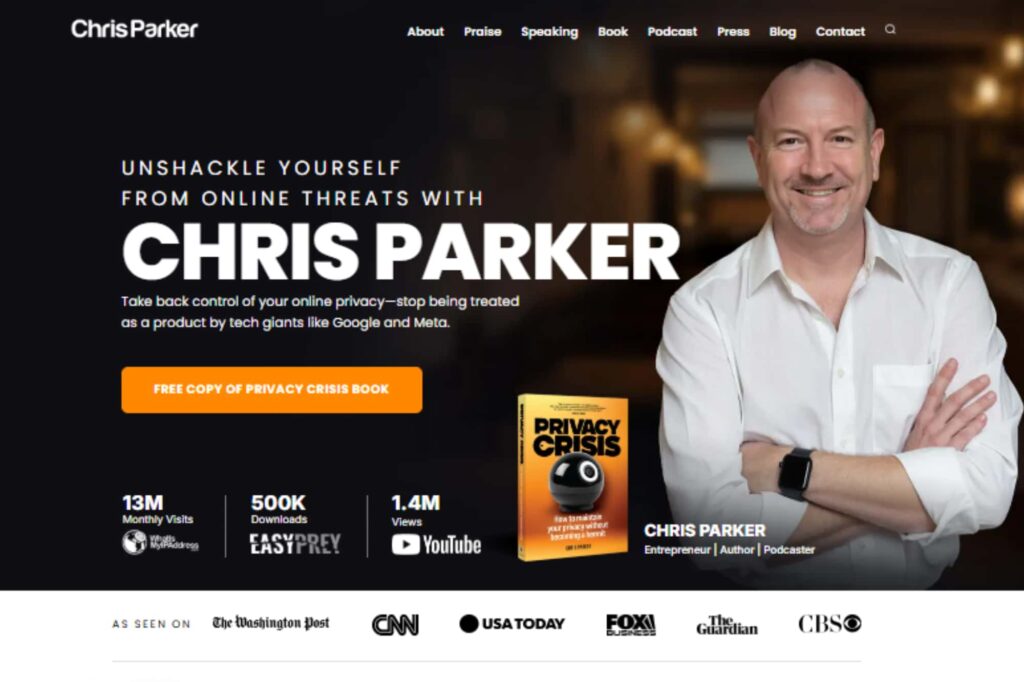
And then we’ll show you just quickly the easy prey. That’s the old one. We’ll come back to this in more detail after, but here’s his new, easy prey website. And so they kind of have a similar vibe with high contrast. Then, yes, we’re kind of cross-promoting each of the websites on the others.
They’re such great photos.
As you know, if you’re a personal brand, photos of you can be dated within five years; you’ll look a lot older than you did five years ago. So these days, you can actually use AI to generate a photo shoot. That’ll be way better than you could get from a professional photographer these days. And I’ll give you an example, right? So what we did was that Chris had a professional photo shoot done, and these were okay. They’re not terrible, right?
But we just thought they weren’t that flattering. I’m just skimming through a few of them on my screen now; you know, they’re in different attire, such as suits and shirts. And look, they’re okay. We put it on the website, but it didn’t resemble what we had envisioned in the mockup design phase; it just wasn’t the look we were trying to capture. So, even though we gave him a bit of direction for what we wanted to see,
In the future, brand is all you’ll have. Personal brand lasts from cradle to grave. Share on XThen we said, “Well, okay. We’re now using AI to generate photo shoots.” And by the way, photo shoots can cost $5,000 if you opt for a professional photo shoot where the photos are edited, and they’re well worth it. However, you can achieve a similar result with AI, and here’s how we do it. So we just ask the client to send us, you know, 20 photos of themselves. I’m just showing a few. I’m not going to zoom in on them because, for privacy reasons, I know, but we’ve included all the ones that featured his family as well, along with just a few photos of Chris taken on his phone.
They don’t need to be professional; some of them are wearing beanie hats and different outfits, and they were shot in various lighting and angles. And so, what we do is train an AI model. There are various AI tools out there that can do this, such as headshots, which are called ‘headshots.’ However, we found one in Canva, which anyone can access. You just look up the AI headshots app within Canva, and you’ll find this incredible tool. There’s an art form to using it. But what we do is we upload 20 photos to it.
We provide it with various prompts, and then it produces some images. That is a good starting point when, after it’s trained, the model, right?
So it’ll just produce these types of photos that we’re looking at now, which look fantastic. And so from there, we can then share it with the client. The client lets us know which photos they like and which ones they don’t. And then, there’s a big mix in this folder that we’re looking at now, including photos that he liked and those that he didn’t.
And then, we can edit those photos, or we can train and retrain the model on the photos that he likes to create new ones. And then we can place them in any scene we want, have him speaking on stage in front of a crowd, and have him wear whatever he likes. You know, we can also change what he’s wearing. It’s just endless what you can do. So, yeah, this is the future of photo shoots to me. It’s just incredible what you can do today. And yeah.
AI doesn’t replace authenticity—it helps align your image with your brand vision.
Then, we do a little bit of Photoshop work, and when we look at the final photos on his website, they just match the brand. You know, it just has the right look. Chris loves them. Chris said to us, It’s just so uncanny. These photos look incredible. They look just like me, but I wasn’t there. He was quite surprised by how good they turned out. So, yeah, we’re loving this photo shoot with AI these days. But yeah, what are your thoughts on that, Stephan?
Yeah. It’s so much more viable for folks. You’re not spending $ 1,000 or $2,000 on a photo shoot. You’re not investing all the time and energy in picking out different outfits, going to the location, arranging a mutually convenient time that suits both the photographer and yourself, and potentially traveling to another city for it, and so on.
And it’s so much easier to update the photos. It’s just a new set of prompts instead of packing up and going back to the photographer for another round. So you can gain more up-to-date contemporary photos of yourself as time goes on. It’s, yeah, it’s a no-brainer.
Some people think that it’s not in integrity or whatever, because it’s not really you that was an AI. The way I think of it is, if you’re going to use AI in your business, which is going to be everybody, otherwise you’re going to be out of business, then think of how onerous it would be to disclose every single place where you are using AI in your business. That’s just going to be untenable.
Think of every use case for a phone. You’re going to use your phone in every aspect of your business, and you have to disclose it everywhere. I mean, that would be stupid. So this is the future. You know, it’s just that Chris is a little, you know, one step ahead of most people in terms of this use case of AI, but everybody’s going to be on board with it. Is the future. This is the near-term future.
Absolutely. And so we’re using AI in a lot of ways to create websites, you know, with the design, with the copy. You know, there’s a lot that goes into it that you would think is just hiring a professional copywriter or photographer or whatever, but no, not these days.
You can have your team use various prompts to create all the aspects of a website. We’re not quite there yet for turning a fully custom design that we’re creating in Figma into a coded website, but. That’s probably coming at some point very, very shortly.
So, yeah. And some people might wonder, ‘Why am I even considering hiring a company, like Studio1, to do the design when there are already AI tools that can generate a design for me?’ Well, garbage in, garbage out. So, unless you are the most amazing prompt dev engineer that has ever lived, then the platform that you’re using will only generate what you tell it to generate.
And so you have to be a master at your craft. You know, you could have a piano in your home and never have taken lessons, and it’s not that useful, so if you’ve got an AI platform for creating a website design or coding it into HTML, good for you. But that’s just a piano in your living room. That doesn’t mean you know how to play it.
Garbage in, garbage out. A great designer with AI is extraordinary; an average one stays average.
Yeah, I agree. And yeah, like our designers are great, but when they use AI, they’re even better, you know, and I’ve seen a lot of average designers use AI and they get average results. So, yeah, I think it’s garbage in, garbage out, but it’s also about having a creative mindset. And I find AI just gives you more freedom to be more creative because it’s doing all the grunt work that you don’t need to do, you know? So yeah, it’s very powerful.
It’s like, you know, this photo of Chris on the podcast, Mike is like, “okay, that’s great.” But one little bit of, you know, color and vibrancy in the photo. We added a red background and other elements, all of which were created using AI. You can simply think of what you want and tell it, and voilà, there’s a result. So you get to the result a lot quicker using AI, but you have to have the ideas. Know, that’s what I mean. If you’re a good creative, you can come up with these ideas for the average person. You’re probably going to struggle.
However, take a look at the beginning of this website, easyprey.com, to see what it used to look like. It was kind of doom and gloom, talking about the problem. You know, even though the USP, their losses and others’ gain, to me, that compares to this, the new USP on the new website, stays one step ahead of scammers.
Good visual hierarchy, as well as font use, is nice and bold. It then provides a brief description of what this podcast is about. It includes a call-to-action, download assessment, and features some good impact metrics and social proof. And then some call to action.
Yeah, look at that. 500,000 downloads, 1.4 million video views. That’s pretty good.
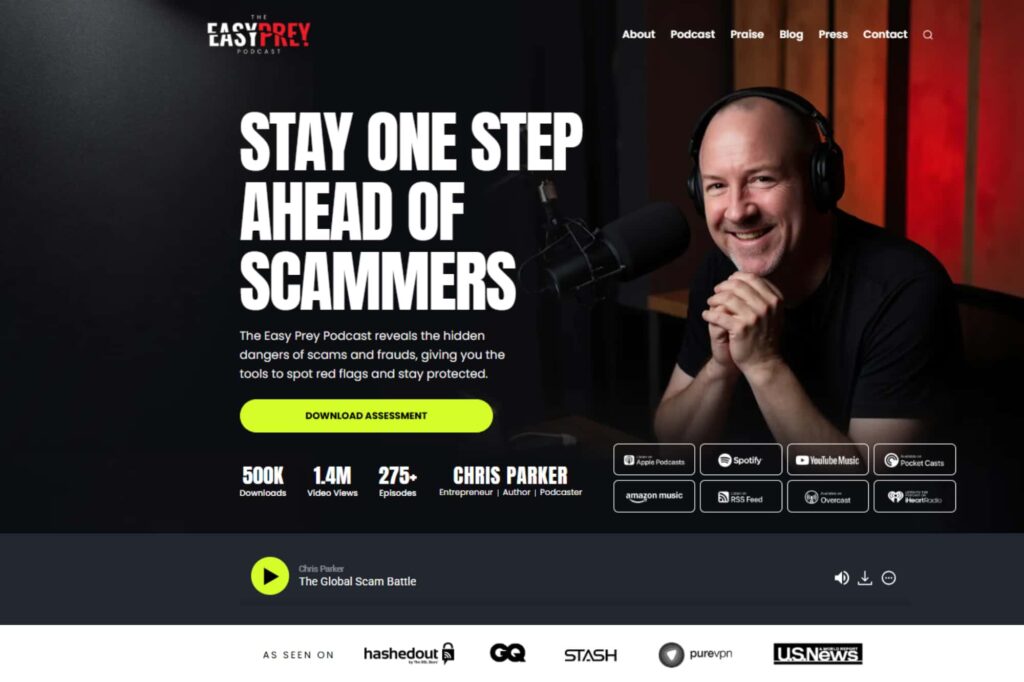
Yeah, exactly. Then, as a little player of the latest episode directly underneath, which is all interactive, and then has some as seen on logos.
Yeah. And those, as CNN specifically mentioned, are his podcast and not the ‘What Is My IP address’ site or both. You know, so it’s like we’re making sure it’s legit and not just, yeah, it’s relevant to the EasyPrey podcast.
Yeah. And then, for added authority, we feature guests who are a big deal in this space, such as Chris Voss. I mean, he’s a big deal in a lot of different spaces, but yeah, Robert Cialdini and John McAfee. Is that how to pronounce his name?

So Chris Voss, author of Never Split the Difference, which is the best book, I think, on negotiating. He’s phenomenal. Yeah. I booked him for my show, and I also got him to be a guest on EasyPrey. Yeah.
Wow, amazing. Yeah. So, all this stuff – Boost Authority, but with a nice design as well. We kind of got this idea from what website? It’s like a movie poster looking for.
Yes, it’s a bit like a combination of Netflix and Masterclass.
Yeah, somewhere in there, but yeah, it’s still uniquely branded for Chris. And it’s also designed in a way that makes it easy for future episodes, such as uploading these to the client’s camera account, so they can simply swap out the photo or other elements to make it easier for them.
Yeah. And all the text is overlaid on top and not part of the image. Even the background, the diffusion pattern, is under the bottom. That’s all overlaid on top of the photo. It’s extremely simple for someone to go into Canva and drop in a photo provided by the guest. And that’s all handled, you know, in the overlays instead of having to do that as part of the Canva template.
Very cool. Yeah. And the latest episodes. And then, yes, we have another area for people to subscribe. Excuse me. The ratings and reviews section. And then, yes, the little section on Chris Parker will then link to his about page, so you can read his journey. We’ll show that in a minute, or perhaps we’ll display it on the personal brand website. It’s kind of similar, isn’t it?
Yes, let’s showcase it on our personal brand.
Sure. All right. We’re there now. So yeah, this is Chris’s personal brand website. Above the fold, we want people to get a copy of his privacy crisis book. And we’re to show a little bit of authority above the fold as well, before we get into, you know, what his mission is, um, you know, and why he’s an expert and what is an expert in, and then we go into his journey so far that led him to this point which we always use this timeline format, which it’s just a really nice visual way to tell your story in bite-sized chunks so that it’s interesting for people and not a boring big slab of text. yeah,
When a client puts together their journey, each milestone needs to be relevant to the purpose of this website. So we’re not just gonna put random things on there, but yeah. We also want to show his personality because people obviously want to know who this person is behind the brand. Yeah. So, yeah, that’s what we’ve come up with. Chris Parker’s websites. Are there any other pages you’d like to review, or would you like to proceed to the results? Cause it’s a long episode.
Diversification future-proofs your business—you can’t rely on one traffic source or website.
Yeah, yeah. No, I think our listener is getting value out of it. So they’re probably still listening. Yeah. To wrap this up, we have multiple websites that offer different approaches to building his business, establishing his authority, and future-proofing his business, as you can’t rely on a single traffic source.
You can’t rely on just one website. And so he is diversifying. So, he becomes a subject matter expert in privacy with a legitimate, really valuable book that has numerous great endorsements, and he has a next-level-looking podcast website featuring high-profile guests on his show. He has his personal brand site that touts him as a subject matter expert, a speaker, an author, and so forth.
So he’s diversified and he’s future-proofed. Whereas let’s say a year ago, before the book was finished, before the websites were built or any of that. It was just whatismyapaddress.com, and the about page on What Is My IP Address kind of hid him behind the scenes because he didn’t want the limelight.
Well, now he’s kind of not forced into the limelight. He’s forcing himself into the limelight. You know, it’s called a forcing function where you say, “Hey, I’m going to lose weight or I’m going to run a marathon” or whatever. And you announce it publicly, and it’s like, “all right, now you’re going to do it.”
And so he’s pushing himself outside his comfort zone so that he can be an even bigger force for good in the world. It’s really cool to see how all this has come together. He had no interest or desire to run a podcast. I convinced him. That was in 2020, when he finally started. And now he’s five years into it, and he’s just a natural at it.
Who knows how many people he saved from their fortunes? He saved their lives with the content that he has put out there. He has done a truly wonderful service to humanity.
Yeah. And he deserves all that. He is such a nice guy. He deserves all the success.
Yes, if you want to support him, consider buying his book, Privacy Crisis, on Amazon for $0.99, even though you can get it for free from privacycrisis.com. Buy it and write him a nice review if you like the book.
Yeah. Couldn’t agree more. All right. So, you have a little case study on your website, stephanspencer.com. Would you like to review the results briefly?
Yeah. So this is a beautiful case study designed by Studio1. Would you like to quickly scroll through it so we can see what it looks like, and then we’ll go back to the beginning? It’s just that it has such a beautiful visual hierarchy, storytelling, and lots of splash and visual interest. It’s not a boring wall of text. The background solution results in a typical results page. This is great storytelling. Yeah.
Yeah, it’s a decent page. Isn’t it? It’s incredible. It’s so long, but with so much value throughout the entire page, and then yeah, it’s cold to action at the end. You know somebody else.
Let’s go back to the top, and then we’ll review this quickly. This is, in my opinion, a best practice example in case studies. So you want to tell a compelling story. It’s not just about you as the service provider. It’s about the hero’s journey of your client. So telling is the story about how he was a tech worker, and he just started this kind of thing for fun as a little side project, not expecting it to really go anywhere. The results were truly impressive. Top 3000 of all websites, et cetera, et cetera. So he went to the engagement of eight years of us working together, 2 million to 13 million unique visits a month.
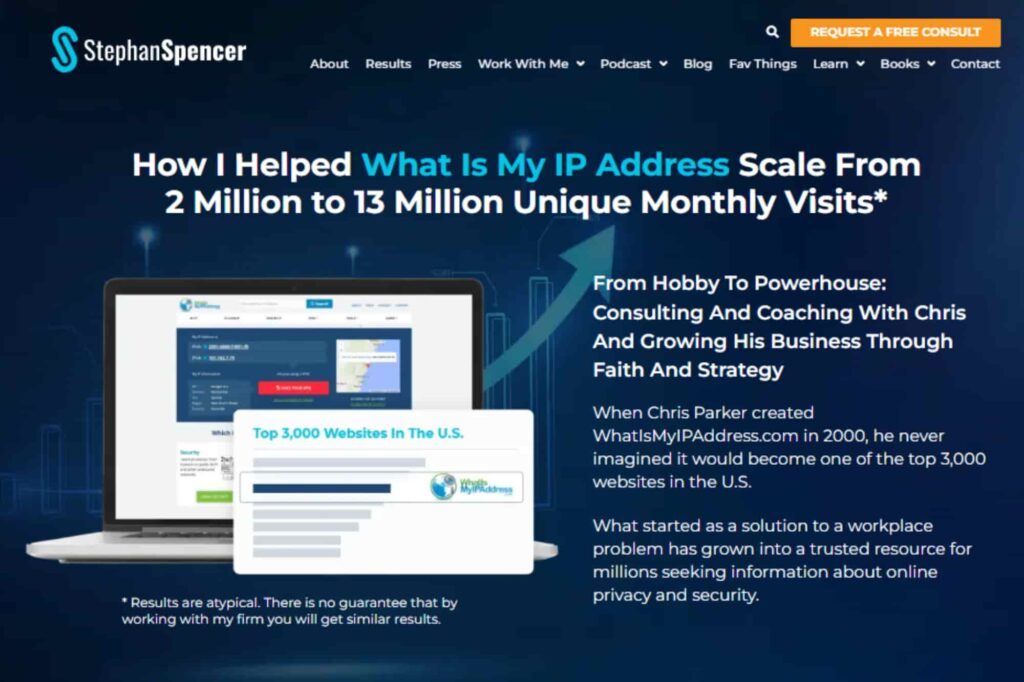
So let’s scroll down to the next section. We’ve got a nice quote from Chris. Let’s scroll down a bit more. Here’s how our relationship began. We met at Affiliate Summit West in January 2017, and he hired me almost immediately afterward, within a few days. And then what did we do to break through the plateaus and really evolve his business and himself personally, because he had been receiving coaching from me the entire time, not just consulting or agency services. It’s my longest-standing coaching client.
Yes, you gave him the advice to write the book and do the podcast, and all those things.
Yeah. However, it’s also about advising on how to improve himself. When you focus on the white light, all the colors of the rainbow are included, and a prism is all you need to display them. Whereas, if you’re chasing individual colors, such as relationships, our business finances, and health, then you have that balanced equation. This lack of balance then leads to other areas of your life. You lose momentum.
You’re so focused on your health that you may lose track of your business. Or, you’re so focused on your business that you may lose your health, heaven forbid. So chase after the white light. That’s got it all, and everything grows. This is an analogy I learned from Kabbalah teacher David Ghiyam, who is well-known in the spirituality space. He’s got a popular podcast, etc. I’ve had him on my show, Get Yourself Optimized. So that’s where I learned about this prism idea, and that’s how I help somebody grow through whatever plateaus, comfort zones, issues, problems, and opportunities they’re facing.
Very cool. All right. So yeah. And then, would you like to discuss the strategic shifts?
Yeah. We’ve discussed several of these larger projects in detail, including developing them into a podcast, becoming a book author, and so on. However, here you can see I’ve got some behind-the-scenes information on the use of AI and the uses and the key, as well as SOPs and so forth.
I actually shared screenshots of the content analysis plan, internal linking plan, site health check plan, and some example briefs for a content revamp. These we call page-level analyses. So a page-level analysis isn’t just, “hey, fix the title tag and add this meta description or whatever.”
It goes in-depth based on keyword research and what we’re trying to achieve, as well as the outcome we’re aiming for. How do we overhaul everything, from headlines and page hierarchy to schema markup, metadata, and interlinking from other pages to this page, and so on? That’s all baked into a page-level analysis. We’ve completed several of those for this client.
And then we actually implement it. So in some cases, the client implements it. And in this case, we implement those. But that’s our roadmap. That’s our plan for executing a high-value page, a pillar page that’s already ranking well and optimizing it to rank even higher.
Amazing. So the results, Stephan.
Yes, so together, you, I, and our teams have experienced an incredible ramp-up in traffic. As you can see here, this screenshot is pretty impressive. We are extremely happy with the results, and our clients are equally pleased. I think this, frankly, if I were in the business of acquiring websites, I’d be knocking on Chris’s door because, as I said, a lot of people are seeing a loss in traffic and a loss in organic keywords because of what’s happening with AI. And people aren’t clicking. They’re not going from the AI overview onto the website. However, we remain in a healthy and viable business, not experiencing a downturn.
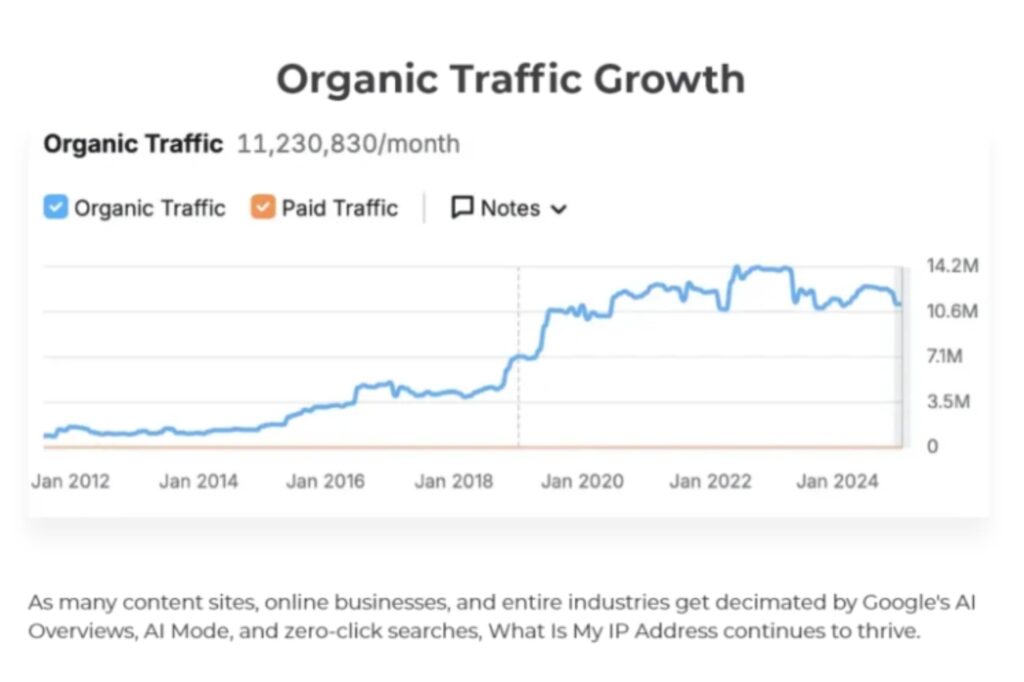
That is, I think, a great acquisition target personally, if I were in the business of buying websites. That is largely due to our collaboration, as we’ve learned from each other and from one another. One plus one equals three. You and I work together really well and come up with some incredible outcomes for our clients. And this is one of them.
Yeah. Love it. Awesome. Would you like to discuss the other results?
So this is a keyword chart. This is from Semrush, which includes SERP features; the primary traffic is coming from here. When you examine keywords, what are the top three positions, the top four through 10 positions, and so on? Additionally, what are the SERP features, including ‘People Also Ask’ boxes, AI overviews, and other relevant elements?
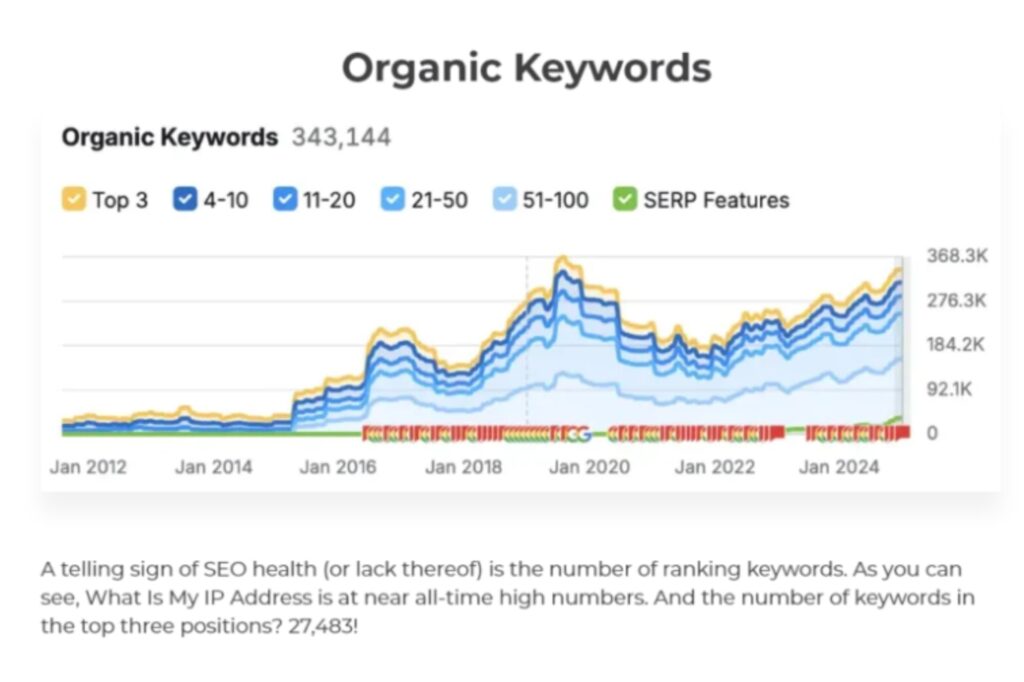
So, you want to track all of that so that you can see how you’re doing with your top three positions. How are you doing with positions four through 10? How are you doing with SERP features and so forth? And it’s not just an overall upward trend in the right graph, which we do see, but also in individual sections of this. If I were to show all these screenshots, you’d see growth in the top three positions and growth in the top four through 10 positions. You’d see a growth in SERP features, search engine results page, SERP. SERP is the acronym.
So anyways, that’s all good. And what gets measured gets managed, as Peter Drucker supposedly said. So we got to measure this stuff so we can start improving and seeing the results.
Okay, this is also a screenshot from Semrush of referring domains. So, we did a lot of link building for him in recent years, but we stopped, gosh, when was it? Like 2024, 2023, and so on, focusing on other projects instead.
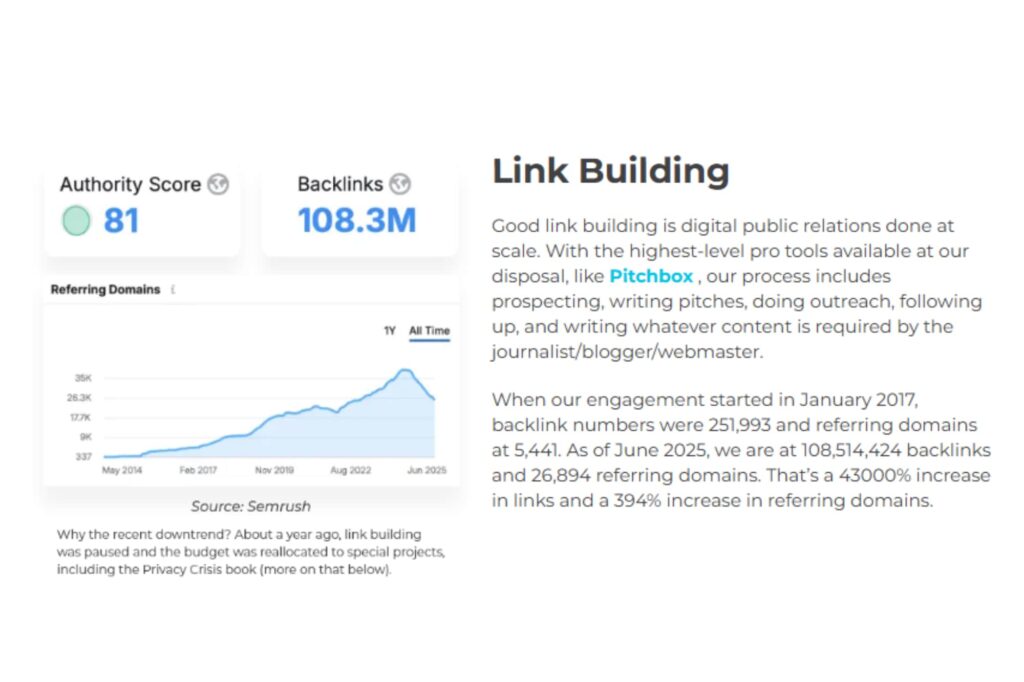
We experienced a slight drop-off in referring domains, but it hasn’t been a significant problem. We got to, you’ve got only so much you can do with a certain budget. So, where do you get the most leverage? And I say, if you can be strategic and come up with something that is outside the box, like becoming an author in your space. And you’re the only author in the IP lookup service provider space that makes a difference.
And really up-leveling your personal brand, as well as all the topics we discussed throughout this entire episode. If you have unlimited resources, great, do it all. But most people don’t. And so with a certain budget and a certain amount of time, what are you going to do? And so we reallocated a couple of years ago, all the link-building budget towards these special projects. And I think the results speak for themselves.
Hmm. Got it. Absolutely. It’s incredible, which is the redesign we’ve been discussing. Obviously, a redesign of What Is My IP Address contributed to the results. However, now that the personal brand upside is her personal brand website upgrade. It’s a long episode, Stephan, but yeah, the whole book, everything to do with that brand and the Podcast website.
So, yeah, onwards and upwards from here. Those three websites are quite new, right, like the redesigns. They’ve only just happened, so we don’t have any official results from them yet. Still, yeah, I guess part of the result is that it will help boost his authority. It goes without saying that with three very professional-looking websites, that’s a function. So yeah, you helped him with all his social media as well.
Yeah. We helped him with YouTube and continue to help them with that. So we have video editors on staff. We have a YouTube specialist. So, you understand the algorithms, thumbnails, titles, playlists, and all that sort of stuff, and how to achieve a higher watch time. So yeah, he’s doing well. We’ve really put him on the map in terms of YouTube shorts.
That was an opportunity he wasn’t leveraging until we got involved on that front. So, he has an internal team for his podcast, and either he was producing his own episodes or his internal team was producing his main long-form video episodes. But the short form ones we did, I think, started a few years ago.
And yeah, that’s definitely a growth area. Additionally, we’ll be helping him create more face-to-camera solo content, allowing him to post content outside of his podcast episodes on his channel. So that’s to come.
Amazing. Yeah. Cool. And another section, essentially discussing our partnership and humanizing his brand. Yeah. Really putting him from, you know, behind the scenes into the limelight, which is really cool. And there we are. He’s been on your podcast a couple of times, and then we have our previous episode where we deconstructed.
Now, this is the placeholder for the episode that we’re recording right now.
Right. There you go. Cool. And then a really nice, yeah, summary at the end of this, I think. And a nice note from Chris as well.
Yes, this is a crucial point. Like, what’s your why? One of his Whys is faith. His faith in God. And one of the great stories of us working together is that he, on his own, decided with his wife to set a stretch goal of a six-figure donation in a single year, which is a significant achievement. And, you know, miraculously, by the end of the year, he had made that amount of money ten times in order to make it equal out to tithing exactly 10 % of his income.
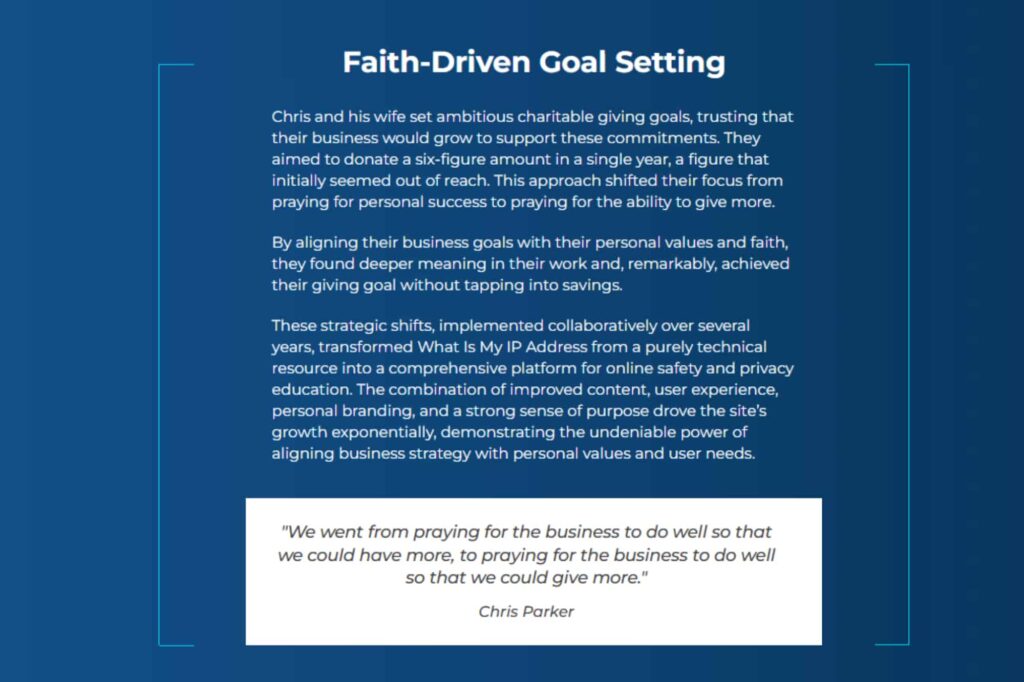
So that was like a big stretch goal out of his comfort zone at the beginning of the year. And then by the end of the year, it was almost to the dollar, and he was like, “Wow, God is good. “
Incredible. It’s amazing what you can do when you set your mind to something like having a call.
Well, when you’re in partnership with God, yeah. You’re not just doing this with the power of your right hand; you’re doing it in collaboration with the All That Is, the Master of the Universe. Because if you think of Him as your business partner, anything’s possible.
When God is your business partner, anything is possible.
Very cool. And then, the overall results, with a summary section to highlight what you’ve achieved together over the last eight years. Yeah. The lesson learned section like this is the next level for a case study page. What’s next?
And it’s so beautifully designed. Thank you, Greg. And thank you, Studio1.
Yeah, that’s right. But thank you for sending Chris our way. But yeah, that’s kind of a wrap. So yeah, incredible results. I guess for me that summary is that the longer you’re with somebody to help guide you, the better. And obviously, for SEO, website traffic, and conversions, all those things help. But, yeah, I would say as well for anybody out there, the main lesson here, I guess, is to compete with AI, compete with your competitors. The only way you can do that is to build your personal brand, and your brand will be the future, if it’s not already. So consider that.
Yeah, I mean, don’t just build your personal brand, build your business brand too, because both are important and one is not the other. So, don’t confuse them, because then you might find yourself in a position like Nicholas is going through right now.
Exactly, Yeah. So keep them separate. Yeah, anything else to add, Stephan, to wrap it up?
No, this was great. And it’s a long episode, but we went through three, no, four websites and several big strategies, actually. Yeah, I think that we delivered a lot of value in this extra-long episode.
Yeah. And look, I just, what I find incredible, just to wrap it up, to the way you work with clients, is you can think really big picture strategy, and then you can get right into the finer details, to know those SEO things that you do. That’s just incredible. It’s really good to see the breadth of how you help clients. It’s incredible.
Yeah, thank you. All right. Well, thank you, listener. Thank you, viewer. This was an extra-long episode. I appreciate you sticking around to the very end. Now, please do something with this. This isn’t just edutainment. You need to apply it in your own business. If you don’t have a business, then, you know, a family member, a loved one, somebody that you care about, help them with their business and get them more traffic, more sales, more reach, more impact in the world. And we’ll catch you in the next episode. I’m your host, Stephan Spencer, signing off.
Important Links
Connect with What Is My IP Address (WIMIA)
Connect with Studio1 Design
Connect with Netconcepts
Apps/Tools
Books
Businesses/Organizations
People
Previous Marketing Speak Episodes
A Case Study in Preeminence, Prominence, and Positioning with Brandon Yosha
Building Trust Through Design: A Case Study with Greg Merrilees
The Real ROI of Good Design: A Law Firm Case Study with Greg Merrilees
Digital Course Website Overhaul: A Case Study with Greg Merrilees
E-commerce Redesign Secrets: A Case Study with Greg Merrilees
Getting the Most Out of Facebook Advertising with Nicholas Kusmich
Local Services Website Teardown: A Case Study with Greg Merrilees
Hacking Your Productivity with Nir Eyal
High Converting Landing Pages with Greg Merrilees
How to Build a Digital Marketing Agency with Stephan Spencer and Greg Merrilees
How to Grow a Site from 0 to 6 Million Visitors with Chris Parker
Mastering the Art of Persuasion with Dr. Robert Cialdini
More Traction, Less Distraction with Nir Eyal
Scaling to 12 Million Monthly Visits with Chris Parker
Secrets to a Persuasive Website with Greg Merrilees
The Enlightened Marketer with Jay Abraham
This Is How You Make a Big Splash with Robert Allen
When Clean Design Kills Conversions: A Case Study with Greg Merillees
Wisdom That Transcends Marketing with the Legendary Jay Abraham
Previous Get Yourself Optimized Episodes
YouTube Videos
Your Checklist of Actions to Take











About Greg Merrilees
 Greg Merrilees is the founder of Studio1 Design. He’s passionate about really good-looking website design that gets results!
Greg Merrilees is the founder of Studio1 Design. He’s passionate about really good-looking website design that gets results!


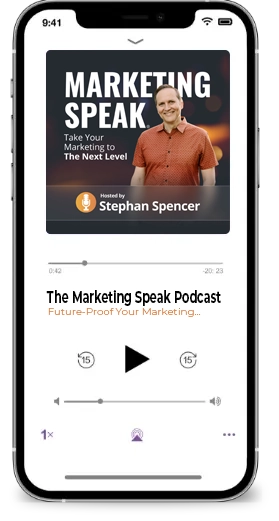





Leave a Reply